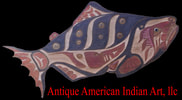The Trading Posts

The Navajo Nation is the largest Native American "Reservation" in the United States covering over 27,425 square miles. Significant sections of Northern Arizona and New Mexico and southern Utah make up the Navajo land.
The Navajo edured the Long Walk of 1868 coming home after 5 years in captivity. Trading Post were set up on the Navajo land as trade became very important to the impoverished Navajo rebuilding their lives again.
Each post had a name, and, more importantly, a trader, who was often wore many hats ... doctor, translator, lawyer, and businessman who often married to a Navajo and had children. The trader also exerted influence on the weavers choice of color and pattern. As blankets and rugs from the same region developed a general look, it became identified with the Region or Trading Post name. Hence, a red field rug with heavy cross or central lozenge motifs is often regarded as a "Ganado" for this style of color and pattern was a favorite of the famous trader, Lorenzo Hubbell fof the often woven by weaver near the Ganado, Arizona, Trading Post
The Navajo edured the Long Walk of 1868 coming home after 5 years in captivity. Trading Post were set up on the Navajo land as trade became very important to the impoverished Navajo rebuilding their lives again.
Each post had a name, and, more importantly, a trader, who was often wore many hats ... doctor, translator, lawyer, and businessman who often married to a Navajo and had children. The trader also exerted influence on the weavers choice of color and pattern. As blankets and rugs from the same region developed a general look, it became identified with the Region or Trading Post name. Hence, a red field rug with heavy cross or central lozenge motifs is often regarded as a "Ganado" for this style of color and pattern was a favorite of the famous trader, Lorenzo Hubbell fof the often woven by weaver near the Ganado, Arizona, Trading Post
